Microsoft Surface Pro Review
by Anand Lal Shimpi on February 5, 2013 9:00 PM ESTDisplay: Awesome if Calibrated
Surface RT used a 10.6-inch 1366 x 768 display, for Surface Pro Microsoft integrated a full 1920 x 1080 panel of the same size. The increase in resolution is appreciable and you definitely notice it when switching between the two Surface models. Pixel density isn’t class leading, but it’s at least in the right range. On the desktop, Microsoft enables 150% DPI scaling by default which makes everything legible but still a bit odd in applications that don't deal well with fractional DPI scaling. Ideally I would've liked to have seen a clean doubling to avoid this mess.
The higher res display just makes everything sharper in the modern UI, and the 150% DPI scaling in desktop mode makes everything big enough where the higher res isn't a problem there. It's only in those desktop applications that don't properly implement Windows DPI scaling where the higher resolution is a hindrance. I actually ran into this problem using Chrome on the desktop, where my taps wouldn't always map to the right parts of the application (not to mention that Chrome in DPI scaled Windows looks terrible). Thankfully there is always the pen...
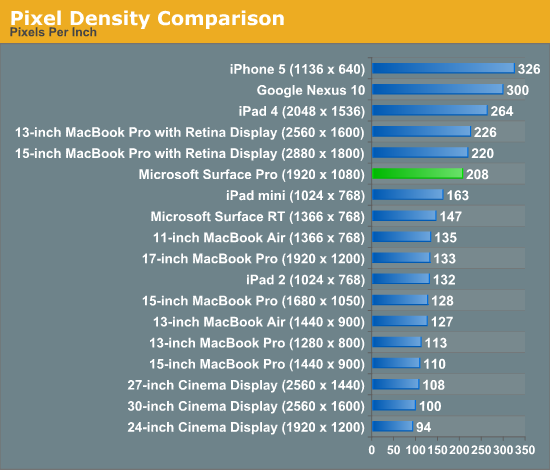
Once again Microsoft doesn’t do any substantial color calibration at the factory, but unlike on Surface RT you can run your own Windows display calibration software on Surface Pro to improve color accuracy if you have the right equipment.
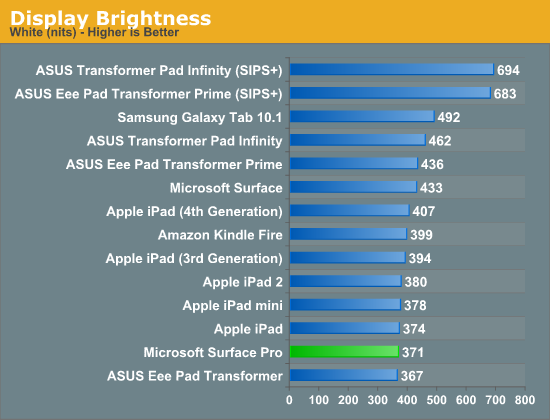
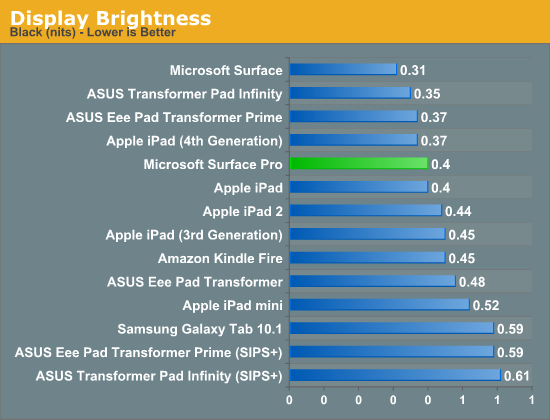
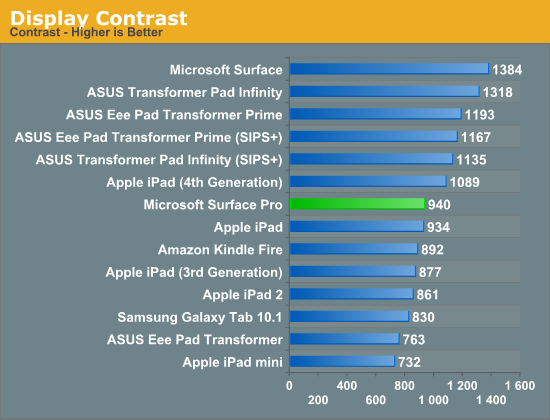
Out of the box my Surface Pro sample had an unusually high white point (~7500K), which negatively impacted its grayscale accuracy. To evaluate color accuracy I turned to our own Chris Heinonen's CalMAN smartphone/tablet workflow. Color accuracy is near identical to Surface RT, which is to say that it’s ok compared to PC notebooks from a couple of years ago but still far behind what you get out of the box from Apple.
Given that the majority of users don’t do any color calibration on their PCs, this becomes a real problem for consumer perception if your tablet doesn’t ship with accurate colors by default.
To see what the panel is capable of I ran it through our standard PC display calibration routine (which I can do since it’s running Windows 8 and is effectively a PC). I then re-ran it through our CalMAN smartphone/tablet workflow and ended up with much more pleasing results. While the display still lagged behind the iPad in one of the tests, it bested Apple’s Retina Display in the other two color accuracy benchmarks.
We'll start off by looking at the calibrated white point for these tablets. What you're looking for here is a number close to 6500K:
The next three charts look at accuracy represented as a difference between various source colors and what's reproduced on the display. The results are presented as average dE2000, with lower numbers being better.
First up is Grayscale performance, here we're looking at the accuracy of black, white and 19 shades of gray spread in between the two extremes:
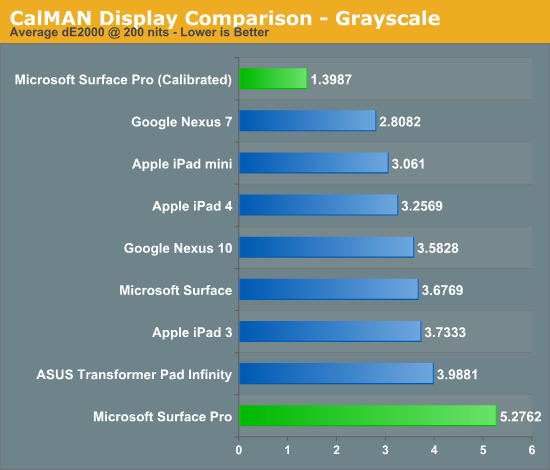
Out of the box grayscale performance is abysmal on Surface Pro. Calibrated accuracy, on the other hand, is just awesome.
First in our color accuracy tests is a saturation sweep. Here we're looking at 20%, 40%, 60%, 80% and 100% saturations of red, blue, green, magenta, yellow and cyan.
Our saturation sweep is the only test where even a calibrated Surface Pro can't match the iPad, it does do a lot better than Surface Pro without any color calibration however. Out of the box Surface Pro is considerably worse than any Apple tablet.
Gamut CIE Chart

Saturation CIE Chart
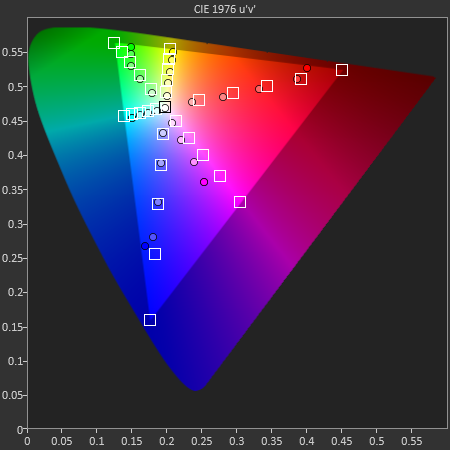
For our final accuracy test we're looking at the difference between a Gretag Macbeth colorchecker chart and the rendered swatches on these displays. Once again, lower numbers are better.
Out of the box Surface Pro and Surface RT are near identical here, and similar to the Nexus 10. With a good suite of calibration tools and supported hardware under Windows 8, Surface Pro has the potential to easily outperform the iPad if given the opportunity.
GMB Color Checker
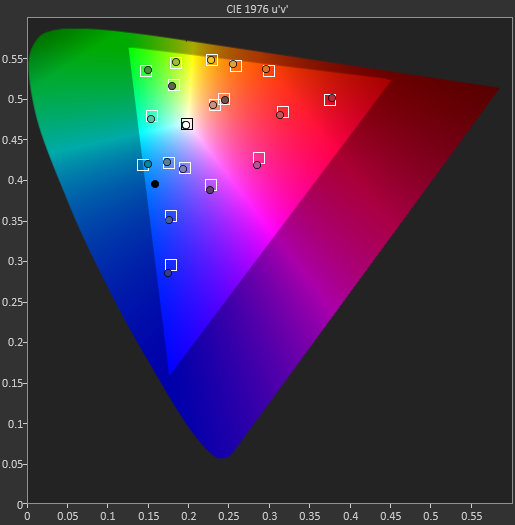
Surface Pro’s panel has real potential, it just needs a calibration pass - which is honestly something Microsoft should be doing these days, not the end user.
Mini DisplayPort but No Thunderbolt
Surface RT featured a single video output in the form of a micro HDMI port. Surface Pro adopts a mini DisplayPort output instead, and will have adapters to enable DVI and HDMI support.
The miniDP output immediately activates as soon as you plug a display into it. I sometimes had issues with display resolutions being set sub optimally, but generally speaking the process was as plug and play as you can get.
I did notice some visual tearing on the Surface Pro display when connected to an external HDMI monitor, similar to what I saw with Surface RT but not nearly as bad. I’m beginning to think something is a bit wonky with Windows 8’s multi-monitor support. What’s interesting is I didn’t see the issue on all displays, which is more than I can say for Surface RT. Update: It looks like this is hardware related. Even if the internal and external panels have the same refresh rate, Intel's HD 4000 won't guarantee that the refreshes will happen at the same time - which is why we see tearing. The tearing should only be present in clone mode, not extended desktop (I'll verify this shortly). It seems like Tegra 3 is worse in this regard, which is why the issue was so much more prevalent on Surface RT. I need to check other Ivy Bridge platforms and under OS X to see if the problem is as prevalent there as well.
The only disappointment here is Microsoft opted against integrating Thunderbolt into Surface Pro. I feel like Thunderbolt would’ve made a ton of sense in a device like Surface Pro, enabling one cable connection to both an external display and high-speed external storage. Given that Thunderbolt adoption remains fairly limited in the PC space I don’t think this is a huge loss for most of Microsoft’s target customer base, but I do feel like it’d be a good way of future proofing the device. The alternative that Surface Pro offers is the combination of miniDP and USB 3.0, which realistically speaking is probably good enough for most users. From a cost of integration standpoint vs. the number of users who would pay for it, it probably didn’t make sense for Microsoft to include Thunderbolt in Surface Pro, but that doesn’t change the fact that I wish it was there. It’d be nice for Apple not to be the only company really pushing Thunderbolt.
Camera Quality
Surface Pro, like Surface RT before it, features two integrated 720p cameras with no flash. Admittedly I didn't spend a ton of time taking photos with Surface Pro but imaging quality is just really bad compared to what you'll get out of an iPad 4. The results are borderline ok for use on the web but that's pretty much it, and forget about decent low light performance.


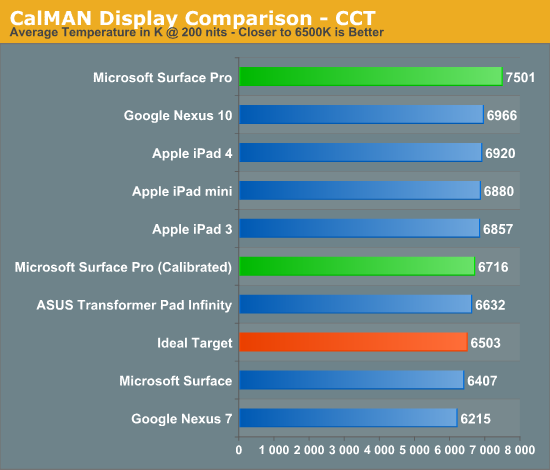
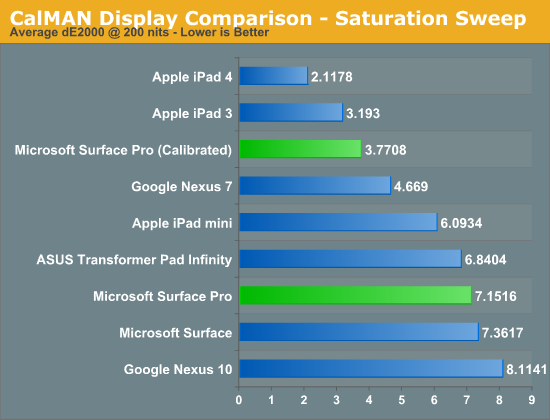
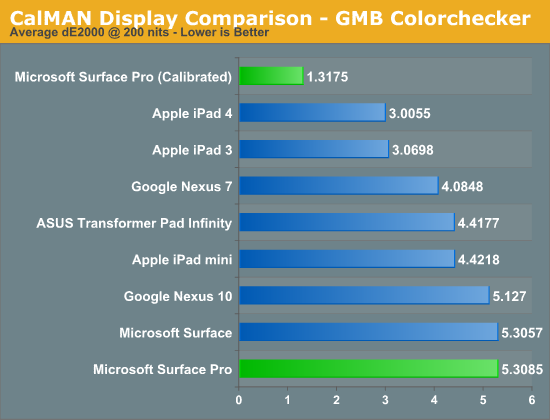










228 Comments
View All Comments
piroroadkill - Monday, February 11, 2013 - link
How about they put all the bulk in the keyboard section, attach it permanently, and get rid of the kickstand? That way you could use it anywhere, even on your lap! Sounds much better.Seriously though, this is a painfully awkward gimmick, and I'd much rather have an ultraportable laptop.
Patrice - Monday, February 11, 2013 - link
I'm a prof photograph and film maker. I use my PCs with adobe production suite and other sotfwares. I have a light version on my laptop too when on a shooting but I thought that the Surface Pro, with a smaller footprint would be the perfect tool as an enhanced monitor and controler (different applications) for my cameras. My wife received an ipad 4 for Christmas and since then I tried to find a usefull application beyond what a 15 year old would do with the thing unfortunately I'm still on the quest of findings something productive (work related) beside converting my ipad into a slate (which I don't need) or a remote control for my tv or my pc.The surface pro looks like a good, (I do not intent to edit or do any post prod on it) idea but if I understand correctly the product has the same disease as the ipad stuff; no video input! I understand Apple's business model to brickwall the user whitin the "I"universe but MS? Why can't I use the Surface as a monitor? After all it offers more than decent quality? Why should it be limited to an AV output??? If my understanding of the product is right, that's a big no no for me, I'm still stuck with a laptop.
The battery drama is real only when you compare the product with non-computer product like Android and the i stuff, I do not have any problem with that as I have a ton of very good batteries that will power the Surface for a long time except that I would need a 12vdc charger (lighter plug) that is not offer on MS shop.
Why is it that when buyng a $1200 I have less technical details then buying a $10 toater? Tried to get an idea about power consumption; over the battery stuff, there is no info, idle power amps, low work load, heavy. I know it depends but would be easy to set a minimum and maximum. The point being that this piece of hardware should be used in more remote location and situation for people than needs the power and freedom of use, this is not for the kids chatting on facebook, this is for working people that needs to do the other stuff.
crispbp04 - Wednesday, February 13, 2013 - link
it has a usb3.0 port, how do you not consider that an option for av input?Soda-88 - Monday, February 11, 2013 - link
Does anyone know what type of SSD is in the Surface Pro? Is it replaceable with bigger mSATA drive for example?Soda-88 - Monday, February 11, 2013 - link
Nevermind, just saw this:Update: It looks like the C400 SSD is an mSATA drive, likely similar to the one we reviewed here a while back.
Marq - Tuesday, February 12, 2013 - link
I feel anandtech is spot on with their view of microsofts product: essentially an ultra book with tablet capabilities. If you were to take such a view you'll find the surface pro rather pleasing. It's funny the way some argue against it. They say the androids and ioses can do the same things and are worth more. A 128gb iPad @ 900usd needs an additional Bluetooth keyboard, can't take USB and is stuck at how much it's given. What's the difference? Yes it gets 9hrs of life. But it can't do photoshop; it can't do GIS applicationS it can't do serious video editing. This device and many others like it (Lenovo, Samsung etc) strides the boundary between tablets and ultra book.This and upcoming generations will make mobile computing true. The androids and iPads are stuck by their oses limitations and will never be able to do what this device does (and they are not meant to).
I will seriously consider this over the MacBook Air if I didn't have one already. The life is similar but the surface pro is smaller and comes with a pen to boot.
dijuremo - Tuesday, February 12, 2013 - link
The Samsung ATIV Pro 700 has been out since December of last year packing the same CPU, 4GB of ram and 128GB SSD. Claiming that the Surface Pro is easily the fastest tablet on the market just sounds as if you were paid to write this review....
http://www.samsung.com/us/computer/tablet-pcs/XE70...
JLQ - Tuesday, February 12, 2013 - link
So far I've actually enjoyed using this device except for the fact that there are no WinTab drivers for the Wacom digitizer. That means no pressure sensitivity in many graphics applications like Photoshop and Corel Painter, which is a huge bummer for me. Lisa Gade is the only reviewer that I've seen that discusses this.For now, I'm waiting and seeing if WinTab drivers will be provided in the near future. Otherwise, I'm making do with ArtRage for the time being, given that it supports Microsoft's newer pen API and thus does register pressure-sensitive input. Touch controls (pan, zoom, rotate) are an added plus.
Imaginer - Saturday, March 30, 2013 - link
I agree with you. I too enjoyed light gaming, CADing, and used ArtRage. Corel Painter 12 doesn't support pressure, but finger pinch zoom and two finger rotate works. I do not understand the people saying the better option is making do with price equivalent of a ARM tablet and a laptop.For as I used my Kindle Fire, I wished I can view things as smoothly as my PC and work with it better in terms of input, both hardware and software. I like my Envy 14 1st generation laptop, but I have and still do an awkward disconnect with using my Intros with it. Even placing the digitizer on tip of the Envy's keyboard still is awkward for lap use as I have to remove it for keyboard use.
Hence I am glad and have gotten a Surface Pro. I was considering the Samsung ATIV 700T, but if its keyboard dock was heavier with a second battery and maybe second removable mSATA SSD, I would have picked that instead.
I hope some group, either one, solves the pen capability in Painter (and PhotoShop and others too).
Bytre - Tuesday, February 12, 2013 - link
My 128GB has a samsung mzmpc128hbfu-000mv. AS SSD clocks in at 471.31MB/sec read, 252.33MB/sec write on the sequential test. 89.4GB free out of the box, 110GB total capacity (as measured by c: properties).